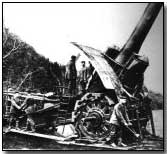Encyclopedia - Barrages
 Artillery barrages were
routine during the First World War, perhaps nowhere more so than in the
static
trench conditions found on the Western Front.
Artillery barrages were
routine during the First World War, perhaps nowhere more so than in the
static
trench conditions found on the Western Front.
Given such conditions barrages were inevitably directed primarily against
enemy trench positions. Depending upon the number of shells fired per
minute a barrage was locally classified as light, moderate or heavy.
Given fewer than 10 shells
over a period of 10 minutes the barrage would be regarded as light. A
moderate barrage would comprise some 30 or so shells per minute; 50-60
upwards per minute would be viewed as heavy.
Various methods of deploying barrages were utilised, including Box Barrages
- comprising shell fire over a specified area with the aim of preventing
enemy reinforcements; Pint-Point Barrages - typically directed at a given
position, invariably
machine
gun or sniper
posts; Search Barrages - often launched with the aim of locating ammunition
dumps or army headquarters, usually as a consequence of intelligence
information from airmen; and Counter-Battery Barrages - which were directed
at enemy guns.
See also Creeping Barrage; Preliminary Bombardment
A "Brass Hat" was a high ranking officer.
- Did you know?
